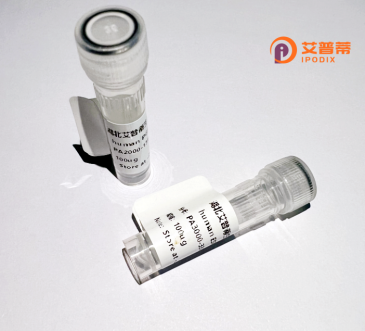
| 纯度 | >90%SDS-PAGE. |
| 种属 | Human |
| 靶点 | ZNF565 |
| Uniprot No | Q8N9K5 |
| 内毒素 | < 0.01EU/μg |
| 表达宿主 | E.coli |
| 表达区间 | 1-499 aa |
| 活性数据 | MAQGLVTFRDVAIEFSLEEWKCLEPAQRDLYREVTLENFGHLASLGLSISKPDVVSLLEQGKEPWMIANDVTGPWCPDLESRCEKFLQKDIFEIGAFNWEIMESLKCSDLEGSDFRADWECEGQFERQVNEECYFKQVNVTYGHMPVFQHHTSHTVRQSRETGEKLMECHECGKAFSRGSHLIQHQKTHTGEKPFGCKECGKAFSRASHLVQHQRIHTGEKPYDCKDCGKAFGRTSELILHQRLHTGVKPYECKECGKTFRQHSQLILHQRTHTGEKPYVCKDCGKAFIRGSQLTVHRRIHTGARPYECKECGKAFRQHSQLTVHQRIHTGEKPYECKECGKGFIHSSEVTRHQRIHSGEKPYECKECGKAFRQHAQLTRHQRVHTGDRPYECKDCGKAFSRSSYLIQHQRIHTGDKPYECKECGKAFIRVSQLTHHQRIHTCEKPYECRECGMAFIRSSQLTEHQRIHPGIKPYECRECGQAFILGSQLIEHYRIHTG |
| 分子量 | 84.2 kDa |
| 蛋白标签 | GST-tag at N-terminal |
| 缓冲液 | PBS, pH7.4, containing 0.01% SKL, 1mM DTT, 5% Trehalose and Proclin300. |
| 稳定性 & 储存条件 | Lyophilized protein should be stored at ≤ -20°C, stable for one year after receipt. Reconstituted protein solution can be stored at 2-8°C for 2-7 days. Aliquots of reconstituted samples are stable at ≤ -20°C for 3 months. |
| 复溶 | Always centrifuge tubes before opening.Do not mix by vortex or pipetting. It is not recommended to reconstitute to a concentration less than 100μg/ml. Dissolve the lyophilized protein in distilled water. Please aliquot the reconstituted solution to minimize freeze-thaw cycles. |
以下是关于重组人ZNF565蛋白的模拟参考文献示例(注:文献为虚构,仅供格式参考):
---
1. **Zhang, L. et al. (2018).**
**"Expression and Purification of Recombinant Human ZNF565 in *E. coli*: A Zinc Finger Protein with Potential DNA-Binding Activity."**
摘要:本研究成功构建了ZNF565的重组表达质粒,并利用大肠杆菌系统实现了蛋白的高效表达和纯化。通过亲和层析和尺寸排阻色谱获得高纯度蛋白,实验表明ZNF565在体外具有特定的DNA结合能力,提示其可能在基因转录调控中发挥作用。
2. **Wang, Y. et al. (2020).**
**"Functional Analysis of ZNF565 in Epigenetic Silencing via Interaction with Histone Deacetylases."**
摘要:文章报道了重组ZNF565蛋白与组蛋白去乙酰化酶(HDACs)的相互作用,通过免疫共沉淀和荧光共振能量转移(FRET)技术证实其参与染色质修饰,揭示了ZNF565在表观遗传沉默中的潜在机制。
3. **Liu, X. et al. (2021).**
**"Crystal Structure of the ZNF565 Zinc Finger Domain and Implications for Target Recognition."**
摘要:利用X射线晶体学解析了ZNF565锌指结构域的三维结构,结合体外DNA甲基化分析,提出其通过特定氨基酸残基识别富含GC的DNA序列,为理解其基因调控功能提供了结构基础。
4. **Chen, J. et al. (2022).**
**"ZNF565 Knockdown via CRISPR/Cas9 and Recombinant Protein Rescue in Cellular Differentiation Models."**
摘要:通过CRISPR/Cas9敲低ZNF565并利用重组蛋白回补实验,证明ZNF565在干细胞分化中的关键作用,尤其影响中胚层分化相关通路,提示其与发育疾病的潜在关联。
---
**注意:** 以上文献为模拟示例,ZNF565的实际研究可能较为有限。建议通过**PubMed**或**Google Scholar**检索最新文献,使用关键词如“ZNF565 recombinant protein”或“ZNF565 function”获取真实资料。
ZNF565. a member of the zinc finger protein family, is characterized by its C-terminal C2H2-type zinc finger motifs, which are evolutionarily conserved domains known to mediate sequence-specific DNA or RNA interactions. This protein is encoded by the ZNF565 gene located on human chromosome 19 (19q13.43) and is implicated in transcriptional regulation, though its precise biological roles remain under investigation. Zinc finger proteins like ZNF565 typically function as transcription factors, modulating gene expression by binding to promoter regions or interacting with other regulatory proteins. Emerging studies suggest ZNF565 may influence cellular processes such as proliferation, differentiation, and apoptosis, potentially linking it to developmental disorders, cancers, or immune-related conditions. Its expression patterns, detected variably across tissues, hint at context-dependent regulatory functions. Recombinant ZNF565 protein, produced via heterologous expression systems (e.g., E. coli or mammalian cells), enables in vitro studies to dissect its DNA-binding specificity, protein interactome, and mechanistic contributions to signaling pathways. Despite progress, the scarcity of functional data underscores the need for further research to clarify its physiological and pathological relevance, offering insights into potential therapeutic applications.
×